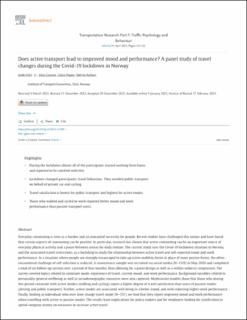| dc.contributor.author | Fyhri, Aslak | |
| dc.contributor.author | Ciccone, Alice | |
| dc.contributor.author | Papaix, Claire | |
| dc.contributor.author | Karlsen, Katrine | |
| dc.coverage.spatial | Oslo, Norway | en_US |
| dc.date.accessioned | 2023-06-13T12:24:17Z | |
| dc.date.available | 2023-06-13T12:24:17Z | |
| dc.date.created | 2023-01-11T16:24:25Z | |
| dc.date.issued | 2023-01-09 | |
| dc.identifier.citation | Transportation Research Part F: Traffic Psychology and Behaviour. 2023, 94 (April 2023), 114-132. | en_US |
| dc.identifier.issn | 1369-8478 | |
| dc.identifier.uri | https://hdl.handle.net/11250/3071165 | |
| dc.description | Published by Elsevier Ltd. This is an open access article under the CC BY license (http://creativecommons.org/licenses/by/4.0/). | en_US |
| dc.description.abstract | Everyday commuting is seen as a burden and an unwanted necessity for people. Recent studies have challenged this notion and have found that certain aspects of commuting can be positive. In particular, research has shown that active commuting can be an important source of everyday physical activity and a pause between arenas for daily routine. The current study uses the Covid-19 lockdown situation in Norway, and the associated travel restrictions, as a backdrop to study the relationship between active travel and self-reported mood and work performance. In a situation where people are strongly encouraged to take up active mobility forms in place of more passive forms, the often-encountered challenge of self-selection is reduced. A convenience sample was recruited via social media (N=1319) in May 2020 and completed a total of six follow-up surveys over a period of four months, thus allowing for a panel design as well as a within-subjects comparison. The survey covered topics related to commute mode, experience of travel, current mood, and work performance. Background variables related to personality, general wellbeing as well as sociodemographic measures were also captured. Multivariate models show that those who during this period commute with active modes (walking and cycling) report a higher degree of travel satisfaction than users of passive modes (driving and public transport). Further, active modes are associated with being in a better mood, and with reporting higher work performance. Finally, looking at individuals who over time change travel mode (N= 151), we find that they report improved mood and work performance when travelling with active vs. passive modes. The results have implications for policy makers and for employers looking for justification to spend company money on measures to increase active travel. | en_US |
| dc.description.abstract | Does active transport lead to improved mood and performance? A panel study of travel changes during the Covid-19 lockdown in Norway | en_US |
| dc.language.iso | eng | en_US |
| dc.publisher | Elsevier | en_US |
| dc.title | Does active transport lead to improved mood and performance? A panel study of travel changes during the Covid-19 lockdown in Norway | en_US |
| dc.title.alternative | Does active transport lead to improved mood and performance? A panel study of travel changes during the Covid-19 lockdown in Norway | en_US |
| dc.type | Journal article | en_US |
| dc.type | Peer reviewed | en_US |
| dc.rights.holder | © 2023 The Authors | en_US |
| dc.description.version | publishedVersion | en_US |
| cristin.ispublished | true | |
| cristin.fulltext | original | |
| cristin.qualitycode | 1 | |
| dc.identifier.doi | 10.1016/j.trf.2022.12.009 | |
| dc.identifier.cristin | 2105243 | |
| dc.source.journal | Transportation Research Part F: Traffic Psychology and Behaviour | en_US |
| dc.source.volume | 94 | en_US |
| dc.source.issue | April 2023 | en_US |
| dc.source.pagenumber | 114-132 | en_US |
| dc.relation.project | Norges forskningsråd: 283321 | en_US |
